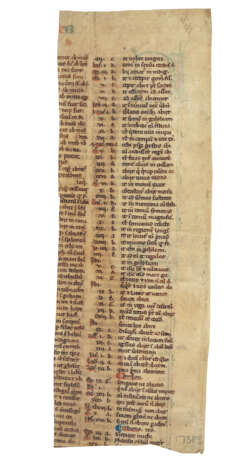ID 869502
Лот 95 | English 14th-century decoration
Оценочная стоимость
£ 1 000 – 1 500
Cutting from the ‘St-Jacques III’ biblical concordance, in Latin, decorated manuscript on vellum [England, 14th century].
With very fine, quintessentially English, decoration: dense penwork with reserved designs, here including a dragon, a hybrid creature, and a heraldic lion and eagle.
c.325 × 113mm. Part of the first leaf of the parent manuscript, preserving the work’s incipit ‘Cuilibet volenti requirere concordantias in hoc libro unum est primitus attendum […]’, the verso extending as far as ‘Abiens’, the incipit and the first proper noun, Aaron, decorated with two fine ornamental penwork initials, one depicts a lion-mask, wyvern, birds, snake, and foliage, the other with two heraldic animals: a lion rampant and eagle with wings spread, paraphs alternately red or blue (cropped at the bottom and fore-edge, with the loss of the bottom two lines and most of a column of text).
Provenance:
(1) Unidentified English bookseller, with pencil price-code ‘l/y’ and price ‘6/–’ (6 shillings).
(2) James Stevens Cox (1910–1997), F.S.A., with his pencil number ‘17383’; he owned at least one other cutting from the same manuscript, with the start of the section of words beginning with ‘P’.
(3) Colker MS 533, probably acquired from Maggs after 2004.
Text
The first recension of this biblical concordance, probably completed by 1239 under the direction of Hugues of St-Cher at the Dominican house of St-Jacques, Paris, provided an alphabetical list of words found in the Bible, and references to where they occurred, but did not provide the context in which the word was used. The second recension provided a biblical quotation to provide the context for the use of each word, but these quotations were too long, and resulted in a volume of awkward dimensions. The third recension, in circulation by 1286, solved the problem by using more abbreviated biblical references. To give an example: the final lines of the verso of the present cutting refer to the word ‘Abiens’. The first reference is ‘Exo. xii. a.’ (i.e. the first part of Exodus 12), and the biblical quotation is ‘benedicite michi’: Exodus 12:32 (according to our modern numbering system) reads ‘Oves vestras et armenta assumite ut petieratis, et abeuntes benedicite mihi’.
The use of the letter ‘a’ to indicate the first part of Exodus deserves some explanation. The present cutting preserves the preface, which explains that ‘Anyone who wants to look for concordances in this book will first of all pay attention to the fact that in the first [recension of the] concordances, those which are called the Concordances of Saint-Jacques, each chapter is divided into seven little sections or parts, according to the first seven letters of the alphabet, namely a.b.c.d.e.f.g. In the present book the longer chapters are divided into seven parts in the same way. But the shorter chapters are divided only into four, namely a.b.c.d., so that in a shorter chapter divided into four parts equal, A contains the first part of the four; B, follows from where the first ends and extends to the middle; C starts from the middle and contains the third part of a shorter chapter; D, after the third part, extends to the end of the chapter.’ This identifies the text of the present cutting as the third recension of the work, or ‘St-Jacques III’. This division of chapters into quarters or sevenths was necessary because there was no standard division into verses.
| Жанр: | Религиозный жанр |
|---|---|
| Место происхождения: | Великобритания |
| Категория аукционного дома: | Манускрипты Средневековья и Ренессанса |
| Жанр: | Религиозный жанр |
|---|---|
| Место происхождения: | Великобритания |
| Категория аукционного дома: | Манускрипты Средневековья и Ренессанса |
| Адрес торгов |
CHRISTIE'S 8 King Street, St. James's SW1Y 6QT London Великобритания | |
|---|---|---|
| Предосмотр |
| |
| Телефон | +44 (0)20 7839 9060 | |
| Комиссия | see on Website | |
| Условия использования | Условия использования |




